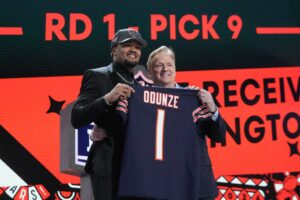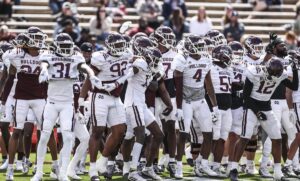The past three weeks should have been focused on the upcoming 2018 season. Fans making plans, message boards getting warmed up, and reading up on all of the preseason magazines. Instead, the crisis of leadership in college football has been front and center.
The Crisis Of Leadership In College Football
There’s no denying that some of the most prominent coaches in the nation have failed to live up to their responsibilities over the past few seasons.
In 2012, Arkansas head coach Bobby Petrino was fired for numerous reasons, including lying to Athletic Director Jeff Long about having his 25 year old mistress on the motorcycle he wrecked. Of course, that is just one chapter in the Bobby Petrino story.
In 2016, Art Briles was fired at Baylor amid an expansive sexual assault investigation that rocked the college football world. Later that year, Indiana University Athletic Director Fred Glass forced Kevin Wilson out at Indiana due to a toxic coaching environment. Wilson told a player with a bone fragment and three damaged discs in his back “I’m paying $70,000 a year for you to sit on your a–.” Wilson is currently the offensive coordinator at Ohio State.
In 2017, Ole Miss head coach Hugh Freeze, seemingly always one step ahead of the NCAA, was fired/resigned for unethical conduct while recruiting.
Now, not even one week into the 2018 season, there are already two major coaching scandals in college football. Urban Meyer was placed on paid administrative leave for two weeks and subsequently suspended for three more weeks for improperly handling domestic violence accusations against one of his assistant coaches.
Meanwhile at Maryland, former Urban Meyer assistant D.J. Durkin is suspended pending the investigation into the death of Jordan McNair on May 29th. After McNair collapsed, it took almost an hour for the Maryland staff to contact emergency workers. Now, there is further allegations that Durkin paid for attorneys to represent two players accused of sexual assault in 2017.
Why?
Five major instances in three years among 65 Power Five programs. That’s not counting significant allegations against other head coaches that never reached major story status. It’s far too many. But why does it seem like there’s a major Coaching Breaking Bad story every six months?
CEO Mentality
The biggest reason why coaching scandals are becoming more prevalent is because of the shift of mentality at the elite coaching level. Programs are looking for “CEOs: Chief Executive Officers” for their multi-million dollar head coaches. Sounds nice. Briefs well. But, here’s the thing: CEOs are managers that are focused on maximizing profits for their shareholders. If one of their employees gets arrested, it’s not part of their job description to handle that. If it’s not a work issue, CEOs don’t get involved.
Coaches lead. They don’t manage.
Leadership isn’t about the bottom line. You can’t really define leadership, but at the college level it’s about connecting and guiding young men into adulthood through the vehicle of football. It’s more about mentorship and counseling than profits and bottom lines. We talked with a handful of college coaches for this story, and when asked about their leadership philosophy, each one of them mentioned the student athlete. Not one coach mentioned wins in his leadership philosophy.
Coaches should see themselves as leaders of men, not corporate bosses.
Cult of Personality
Have you ever watched Last Chance U? Hopefully not with young children around. Again, there is no standard for leadership. Each coach leads in his or her own way. But there’s a fine line between being a tough leader and a toxic leader. Wilson’s departure from Indiana and the abrasive personalities at East Mississippi Community College and Independence Community College paint a picture of this “ideal” college coach.
But this is a misconstrued image. Coaches are like all of us, sometimes. They can get wrapped up in an image — what they think the world wants them to be. What they think the fans want them to be. What they think their players, peers, and administrators want them to be.
This is enabled by fans who like personalities and administrators that buy into personal branding. This is likely what happened in the Wilson and Durkin situations.
Authenticity is important. It is a critical ingredient in quality leadership. The cult of the coaching personality, driven by television and popular culture, demanding yelling and screaming, erodes the leadership ability of those that it affects.
Misplaced Loyalty
This is the hardest part about leadership. Loyalty is important in any relationship or partnership. But leaders place their loyalty, and the loyalty of their programs, not to themselves, but to something higher. In the case of college football, placing loyalty to an assistant coach or a player over the potential risk to a program is potentially devastating.
This is the art of leadership. There’s no equation or call sheet that can tell you when someone deserves a second change, when something doesn’t rise to the occasion of discipline. But effective leadership occurs before bad things happen. If an assistant coach or a player makes an egregious mistake, one of two things has happened. Either the leadership beforehand wasn’t effective, or that person has put the leader in a compromising situation. Either way, the program should come first.
This is clearly what happened in the Ohio State scenario. Meyer placed his loyalty to his mentor, Earle Bruce, above his loyalty to the Ohio State program. His protection of Zach Smith was borne out of his loyalty to Bruce. In doing such, he has irreparably damaged his own reputation and that of Ohio State.
Effective leaders make it clear early and often: no one is above the program. And effective leaders create environments that prevent bad things, not environments where they have to make bad things go away.
It Takes A Village
Leadership isn’t a one-way street, however. It’s an integrative action. It’s not just coaches that have a role in this crisis.
Meet The New Boss
Administrators at every school are also responsible. That includes athletic directors and university presidents. Sometimes coaches do what they do because they know that they can get away with it. When the coach makes twenty times more than his boss, it can sometimes cause the administrator to see things from the coach’s perspective far too quickly.
Administrators need to be leaders as well, not just facilitators for millionaire head coaches. The reason Mike Slive held so much sway in the SEC is because the conference presidents entrusted their faith and confidence in him. Coaches knew that when Slive spoke, he had the absolute support of every school president.
Same As The Old Boss
Boosters and media create conditions that force coaches to sometimes make decisions that are personally beneficial rather than beneficial to their programs. Sure, college football is a business. There’s no doubt that millions and millions of dollars make leadership tougher. But that’s why leadership is so special. You’ve got to find the good ones — the ones that can handle all of the demands of the modern day coach the right way.
Won’t Get Fooled Again
And yes, fans have a role in this as well. It’s a common refrain: big time coach gets in trouble, home fan base defends him to the tilt. Fans should demand better. Fans should demand better when bad things happen, but they should also demand better transparency in the decision making process of their alma maters and their universities.
For Ohio State fans to accept the hires of Zach Smith, or especially Kevin Wilson and Greg Schiano, should immediately raise red flags. Fans, local media, and national media must hold their program leaders more accountable in their decision-making. Remember, critical to effective leadership is creating ecosystems where positive things strive and bad habits have a hard time taking hold. For Buckeyes Athletic Director Gene Smith to allow the hires of Schiano and then Wilson and for Maryland to hire D.J. Durkin, the stage was already set for some catastrophe to occur.
Is There A Fix?
The idealist will say that poor leadership isn’t a crisis in college football. Or, if it is, it can be fixed. The pessimist will say that the sheer amount of money involved ensures nefariousness within the business. So, is there a fix?
Transparency
Poor leadership from coaches isn’t new. In his book “I’ll Tell You When You’re Good (America’s 12th Man Quarterback)”, former Texas A&M quarterback David Walker details how head coach Emory Bellard hid the severity of his injury from him and his parents. According to Walker, Transparency is the key:
“Transparency is the only way to protect them [student-athletes]”
In each of our conversations with coaches, they all mentioned social media. The common statement was “social media has changed the game.” That’s true. Now that players and parents have an ability, through social media, to critique a coach on a large level, coaches have even more pressure to make everyone happy. Coaches might not like social media, but it is an effective check on the absolute power they wield in training complexes across 65 universities.
The solution is simple: Re-focus.
Athletic Directors and University Presidents need to reduce the scope of the head coach position. They also need to rein in boosters. This helps the coach by allowing him to focus on the players. You can laugh at Arizona State‘s hire of Herm Edwards during the off-season, but it is the model that will help fix this crisis of leadership in college football.
Fans need to focus on the players rather than idolize the coach. They need to demand more from their university and program leadership. You can ridicule Tennessee fans all you want, but their online rebuke of University leadership during the last coaching hire has proven to be absolutely right in retrospect.
Lastly, the coaches need to re-focus on those in their charge: the student-athlete. If you’re into Xs and Os, go to the pros. College is about the Jimmys and the Joes.
Back To The Game
The game of football has an uncertain future. The discussion about concussion and other health issues are causing a decline in participation in youth football. In the NFL, social issues are causing a rift between players, owners, sponsors and fans. The crisis of leadership in college football also contributes to this uncertainty.
To be clear, there are many great coaches involved in college football. But coaches are entrusted with the development and mentorship of young men; therein lies a responsibility for the coaching community to be as professional as possible through both internal policing and external pressure.
Eventually, no matter how much money is involved, fans will tire of coaches enabling abhorrent and illegal behavior from their staffs and their players. They’ll reach a breaking point as they watch their programs rot from the inside out, even if they’re winning shiny new trophies. They’ll demand the cleansing of toxic environments.
Let’s just hope it doesn’t happen too late.
Main Photo:
Embed from Getty Images






